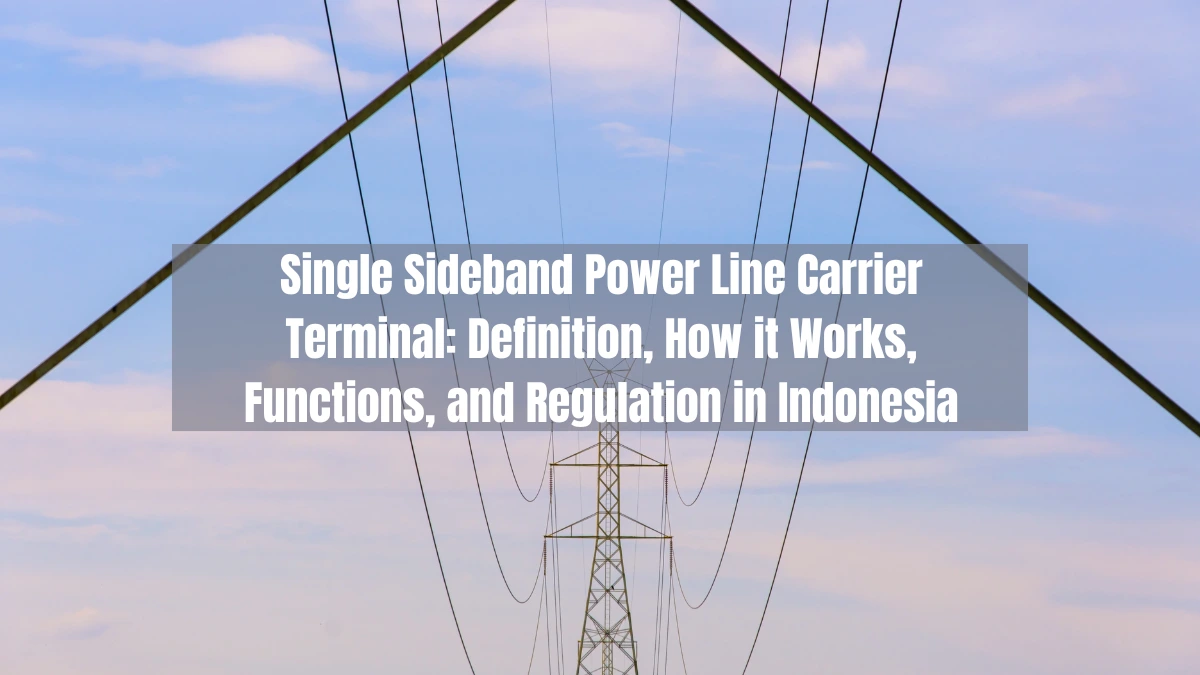Single Sideband Power Line Carrier (SSB PLC) Terminals are an important element in achieving efficient utilization of the frequency spectrum.
Are you familiar with the Single Sideband Power Line Carrier Terminal? This device serves to utilize the existing power grid for communication purposes.
This article discusses the Single Sideband Power Line Carrier Terminal, starting from the definition, how it works, main components, and functions, and outlines the regulatory landscape governing its use in Indonesia.
Also Read
Table of Contents
What is a Single Sideband Power Line Carrier Terminal?

Single Sideband (SSB) Power Line Carrier Terminal is a unit in a power line carrier (PLC) communication system that implements SSB modulation.
Through this modulation, only one sideband of the signal is transmitted, resulting in more efficient utilization of the frequency spectrum than standard amplitude modulation (AM).
The implementation of SSB in PLCs provides a number of benefits, including spectral efficiency, resistance to noise and interference, and improved transmitted signal quality.
How Does Single Sideband Power Line Carrier Terminal Work?
In general, Single Sideband (SSB) Power Line Carrier (PLC) Terminals work by transmitting data signals using one sideband of a carrier signal, which is then superimposed on the power grid. Here is how it works in detail:
- SSB modulation changes the frequency of the signal: The data signal to be transmitted is converted into a radio signal with a frequency tailored to the bandwidth and energy requirements, using the single-sided band (SSB) modulation method.
- The carried SSB signal is added and adjusted: The SSB-modulated data signal is added (superimposed) on a carrier signal whose frequency is adjusted to that of the power grid (e.g. 50 Hz or 60 Hz).
- Transmitting over power lines: With PLC terminals, such as Power Line Adapters that function as transmitters and receivers transmitting carrier signals that have been modulated with the data signals are transmitted over the power grid.
- Filtering and demodulation: The received PLC signal passes through a filter to separate the data signal from noise and interference. Then, the signal is SSB demodulated, to restore the data signal to its original form.
- Data signal processing: After demodulation, the recovered data signals can be further processed, such as information recovery, or used for various applications, such as voice communication, teleprotection, or electrical equipment control.
The Components of Single Sideband Power Line Carrier Terminal
There are three main components in the Single Sideband Power Line Carrier Terminal system including the PLCC Terminal, coupling capacitor, and line trap.
- PLCC Terminal: Serves to convert voice and data into high-frequency signals.
- Coupling capacitors: Connect the transmission line with the PLCC Terminal and provide impedance matching.
- Line trap: Serves as a filter to block the carrier frequency and ensure the signal does not spread to other power lines.
The Functions of Single Sideband Power Line Carrier Terminal

The main function of Power Line Carrier (PLC) terminals with Single Sideband (SSB) modulation is to facilitate the communication of data and voice signals through the existing power grid without disrupting the distribution of electrical energy. Here are some of the main functions of the Single Sideband Power Line Carrier Terminal:
1. As data and signal communication
One of the functions of an SSB LLC Terminal is data and signal communication. This device allows the transfer of data, voice, and video signals over an electrical network that can be used for various applications. Applications used include electrical systems, remote monitoring, and internet access.
2. Improving data transmission efficiency
Improving data transmission efficiency is another function of the SSB LLC Terminal. Only one sideband (up or down) of the carrier signal being transmitted helps to reduce bandwidth requirements and improve data transmission efficiency.
3. Allows the use of various applications
Another function of the SSB LLC Terminal is its ability to be used in various applications. PLCs are used in various applications such as protection relays, telemetry, telephony, and home automation.
The Regulation of Single Sideband Power Line Carrier Terminal

Single Sideband Power Line Carrier Terminal products sold in Indonesia must be certified by the Directorate General of Digital Infrastructure (DJID) under the Ministry of Communication and Digital (KOMDIGI). This is based on PERDIRJEN No. 8 Tahun 2019, which requires all radio frequency-based devices, including SSB LLC Terminal, to meet specific technical standards before being sold in the country.
DJID certification ensures that the product meets government safety and quality regulations and does not interfere with other communication devices. The certification process involves technical testing, such as frequency adjustments, safety checks, and compatibility with the surrounding environment.
Once the tests are completed, products that pass are listed in a Test Result Report, which confirms that the product is safe and ready for sale in Indonesia. This report reassures customers that the product meets technical standards and is secure.
For companies wanting to sell a SSB LLC Terminal in Indonesia, Type Approval Certification Services for ICT Products are available to assist with this process. This service includes preparing technical and legal documents, conducting required testing, ensuring compliance with regulations, helping companies streamline the certification process, and giving consumers confidence in certified products.


















